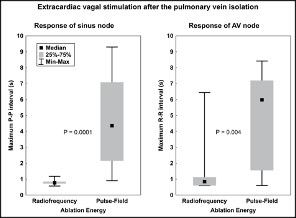ACUTE CHANGE IN PARASYMPATHETIC CARDIAC INNERVATION AFTER PULMONARY VEIN ISOLATION BY PULSE-FIELD AND RADIOFREQUENCY ENERGY
Tématický okruh: okruh | |
| Typ: Ústní sdělení - lékařské , Číslo v programu: 48 | |
| Stojadinović P.1, Peichl P.1, Wichterle D.1, Čihák R.1, Hašková J.2, Jansová H.2, Nejedlo V.2, Kautzner J.1 1 Klinika kardiologie, IKEM, Praha, 2 IKEM, Praha | |
Background: In patients with atrial fibrillation (AF), pulmonary vein isolation (PVI) by radiofrequency (RF) energy is associated with a significant change of cardiac autonomic regulations due to collateral ganglionic plexi ablation. Pulse-field (PF) ablation energy presumably spares neural tissue. Objective: We compared the effect of PVI by PF and RF energy on cardiac autonomic function. Methods: A study enrolled 23 patients who underwent PVI in general anaesthesia. In 12 patients, a novel lattice-tip catheter and PF energy were used for ablation while 11 patients were ablated using a conventional irrigated-tip catheter and RF energy. The response of the sinus node (SAN) and atrioventricular node (AVN) to extracardiac high-frequency vagal stimulation (ECVS) was tested before and after PVI (via right internal jugular vein; stimulation frequency of 50 Hz; pulse width of 0.05 ms; output of 1 V/kg (<70V); train duration of 5 s). Results: At baseline, physiological massive response to ECVS (sinus arrest and/or AV block) was demonstrated in the majority of patients. After PVI, complete loss of autonomic response of the SAN in 11/11 (100%) and 3/12 (25%) patients (p=0.003), and the AVN in 9/11 (82%) and 3/12 (25%) patients (p=0.01) was observed in RF and PF groups, respectively. The figure shows the maximum duration of the pause in sinus rhythm (maximum P-P interval) and AVN block (maximum R-R interval during atrial pacing) induced by ECVS after PVI. Conclusion: Cardiac vagal response is preserved in a considerable proportion of AF patients after PF ablation which is in contrast with a significantly stronger effect of RF energy. This may influence the clinical outcome of AF ablation procedures. | |
 |